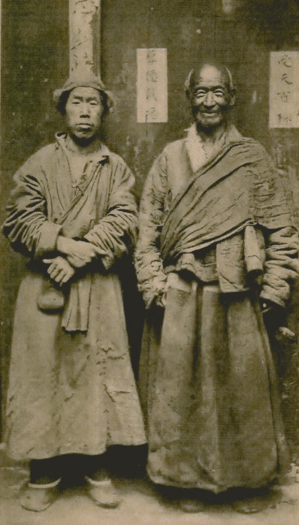1900s Tibetan work
Amdo ཨ་མདོ་

Two Amdo monks, Sen-ce and Sang-Je. The younger man became a Christian in 1906.
The town of Dujiangyan (formerly Guanxian) in northwest Sichuan Province was strategically placed on the edge of the Tibetan frontier. Each summer, Tibetans from many tribes and clans visited the town to gather supplies, before returning home.
James Hutson of the CIM lived in Dujiangyan during the early 20th century. In 1906 he told a gripping story of how a single gospel tract had helped open the hearts of people in one Amdo area:
"Several years ago I sold a Gospel to a Tibetan who lived 15 days' journey northwest of the city. He took it home and gave it to the lama in charge of one of the monasteries. This lama happened to be the brother of a Tibetan chief. He took the Gospel to the chief, and the two looked at it and talked about it. They said to themselves that this was only one portion of a volume, and they would like a complete copy. So they sent that man back, 15 days' journey from the Tibetan border, to get the whole New Testament in Tibetan....
That book is today a light in the midst of the darkness in a place where a missionary has never yet penetrated. Later on there came an invitation to go and preach the gospel to those people."[i]

A gathering of the Christian and Missionary Alliance Tibet Border Mission.
During the first decade of the 20th century the Tibetan Border Mission of the Christian and Missionary Alliance grew significantly, boosted by the arrival of several new recruits. The missionaries' goal was to reach the dozens of unevangelized Amdo tribes and clans scattered throughout the region. The Golog were one such tribe, with a dozen or more subgroups in their midst.
Little was known about the mysterious Golog people, except that when they ventured into Labrang or one of the other monasteries to celebrate festivals, other Tibetans were terrified of them. Later historians retraced the history of the Gologs, finding that "In the seventh century, the Tibetan king dispatched his fiercest warriors, ancestors of the present-day Gologs, to guard the country's mountainous northern frontier against Chinese invasion. When the Tibetan kingdom eventually collapsed, the Gologs stayed in their mountain retreats, defiant of outside authority."[i]

© This article is an extract from Paul Hattaway's book ‘Tibet: The Roof of the World’. You can order this or any of The China Chronicles books and e-books from our online bookstore.
[i] James Hutson, "The Station of Kwan Hsien," China's Millions (July 1906), p. 113.
[ii] Galen Rowell, "Nomads of China's West," National Geographic (February 1982), p. 244.




